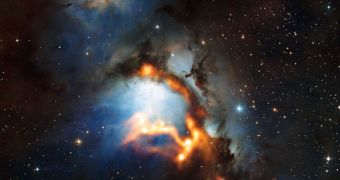Astronomers have recently used the Atacama Pathfinder Experiment (APEX) telescope at Chajnantor, in Chile, to image the reflection nebula Messier 78, which is located very close to the famous Orion's Belt. The image reveals the cosmic structure in unprecedented detail.
The interesting thing about APEX is that, even though it's such a good telescope on its own, it is in fact a pathfinder instrument for the Atacama Large Millimeter/submillimeter Array (ALMA), the next-generation radio observatory being built by an international consortium.
APEX represents the result of a fruitful collaboration between the Max Planck Institute for Radio Astronomy (MPIfR), the Onsala Space Observatory (OSO) and the European Southern Observatory (ESO). The latter operates a high number of telescopes in the Chilean Andes.
The ALMA pathfinder is capable of detecting the heat glow produced by interstellar dust grains. A vast number of such particles are located in the targeted reflection nebula, especially considering that it is a stellar nursery. Cosmic dust is essential to the formation of new stars.
What astronomers were interested in determining is where new stars are being formed inside Messier 78. Intense glow in some areas of the reflection nebula revealed these locations. The glow is caused by new stars heating up the dust clouds from within.
In this new APEX image, the nebula – also known among astronomers as NGC 2068 – takes center stage. The structure looks very different in optical wavelengths, as its classification implies. All astronomers see is a pale blue glow, produced by starlight reflecting on the dust clouds.
This is visible in this composite view as well. Data produced by APEX, shown here in shades of yellow and orange, are overlaid on a blue-colored optical image of the same stellar nursery. The former clearly reveals where the most stars are being produced.
“One filament seen by APEX appears in visible light as a dark lane of dust cutting across Messier 78. This tells us that the dense dust lies in front of the reflection nebula, blocking its bluish light,” an ESO press release explains.
“Another prominent region of glowing dust seen by APEX overlaps with the visible light from Messier 78 at its lower edge. The lack of a corresponding dark dust lane in the visible light image tells us that this dense region of dust must lie behind the reflection nebula,” the statement adds.

 14 DAY TRIAL //
14 DAY TRIAL //